German Tradition
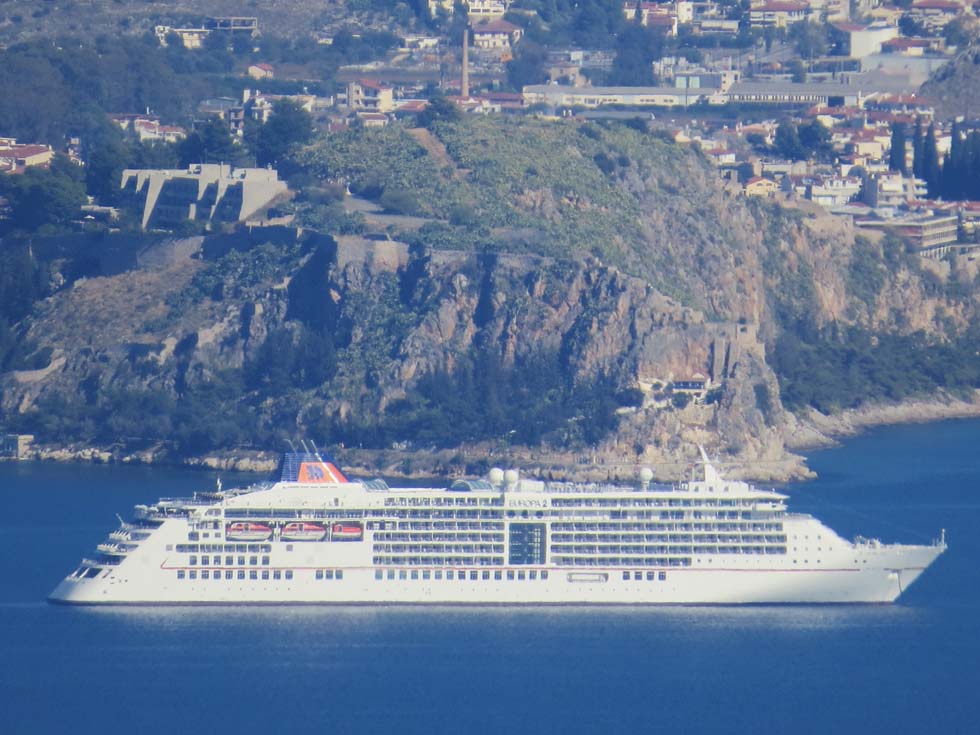
“Europa 2” of Hapag-Lloyd at Nafplion, Peloponnese 2013 (WS)
Download this picture with 1500 x 1000 pix, 300 dpi

When we had been schoolboys, we admired the mockups of Lloyd’s pre-war “Bremen” and “Europa” on display in travel agencies. They represented the myth of the Great World. When cruise shipping developed in the late 20th century, some German newspapers belittled it, but they could not prevent the German market from becoming world’s third-largest – its major providers being in foreign hands, represented by AIDA, MSC and others.
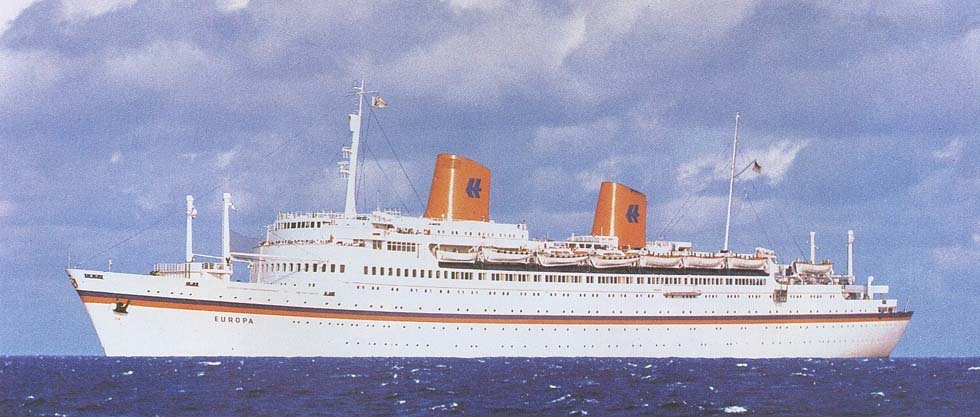
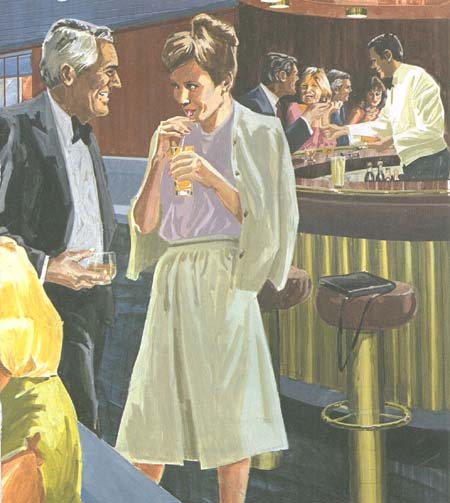 “Europa” of Hapag-Lloyd, ex “Kungsholm” of 1953 (Hapag-Lloyd ad of the 70s, coll. HSch)
“Europa” of Hapag-Lloyd, ex “Kungsholm” of 1953 (Hapag-Lloyd ad of the 70s, coll. HSch)
Hapag-Lloyd
After WWII, Hapag concentrated on the cargo business. Only one pure passenger ship had been acquired in 1957, the “Patricia” of Svenska Lloyd, introduced as “Ariadne” (7,764 gt) on cruises. As the result proved unsatisfactory, the ship was sold in 1960. Competitor Norddeutscher Lloyd (NDL) resumed its North Atlantic services (see the relevant chapter), but took more and more to luxury cruises. The “Berlin” (1925/18,600 gt ex “Gripsholm” I of Svenska Amerika Linjen) had her first cruise voyage in 1955. She was scrapped in 1966. The prestigious steamer “Bremen” (33,336 gt, built as “Pasteur” of Cie. Sudatlantique) undertook cruises from 1960 and was sold to Chandris in 1972. NDL amalgamated with Hapag in 1970 and formed the Hapag-Lloyd AG. The last among the NDL Atlantic liners, the “Europa” (1953/ 21.514 gt, ex “Kungsholm” of Svenska Amerika Linjen), changed completely to de-luxe cruises in 1972 and the traditional livery of black/white with ochre funnels was replaced by the new white colour scheme with an orange/blue ribbon. With completion of a new “Europa” in 1981, she became the “Columbus C” of Costa Crociere. The new “Europa” (33,819 gt) made headlines in 1992 when she collided in the China Sea with a container ship. She was tugged to Kaohsiung, where the passengers were disembarked. Sold to Star Cruises, she became in 1999 the “Superstar Europe”, then “Superstar Aries”, “Holyday Dream” of Pullmantur and “Bleu de France” of CDF. In 1997 Hapag-Lloyd was acquired by Preussag AG, then operating as TUI AG, but Hapag-Lloyd Kreuzfahrten remained a separate brand. A new “Europa” was completed in 1999 by Kvaerner Masa Yards, an Azipod-driven 28,890 gt midsize ship. Awarded by the Berlitz Guide with a “5 Star Plus” classification, she represents the highest level of traditional noblesse, offering round-the-world travels as the flagship of a fleet including also the smaller “Bremen” (ex “Frontier Spirit”), “Hanseatic” (ex “Society Adventurer”) and “C. Columbus”. This 14,903-ton ship, built at Wismar in 1997, went even to the Great Lakes. In 2011 the media reported charter of the “Insignia” from Oceania as “Colombus 2”. The first “Columbus” cruised for Plantours as “Hamburg”. In 2011 the magazine Ferries reported a contract for a new “Europa 2” of c.38,500 gt being placed with STX France and, according to the Reise-Journal (Dec.2012), the elegant dress code had to be abandoned. In May 2013 she went on her maiden voyage.
In 2008 Germany was shocked by the media reports that TUI considered to sell Hapag-Lloyd container shipping to Neptun Orient Lines of Singapore in order to compensate for losses of TUI’s airline business. Then Hapag-Lloyd was saved for Germany by the Hamburg-based consortium ‘Albert Ballin’, initiated by Klaus-Michael Kuehne, well-known in the logistics industry. For TUI Cruises, started with a 50% shareholding by Royal Caribbean, see the relevant chapter.
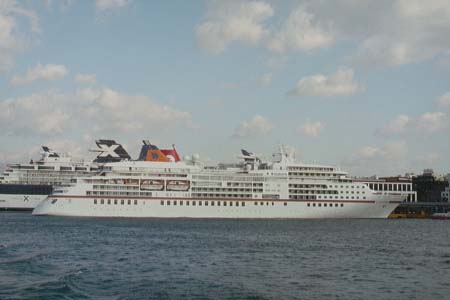
“Europa” of 1999 at Piraeus, 2008 (WS)
|
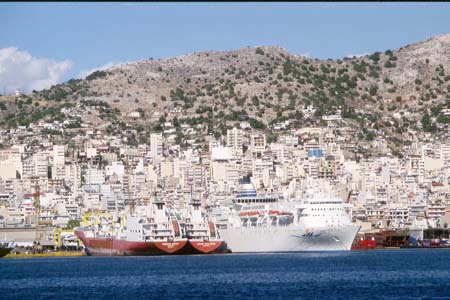
“Bremen”, the former “Frontier Spirit”, Nafplion 2010 (WS)
|
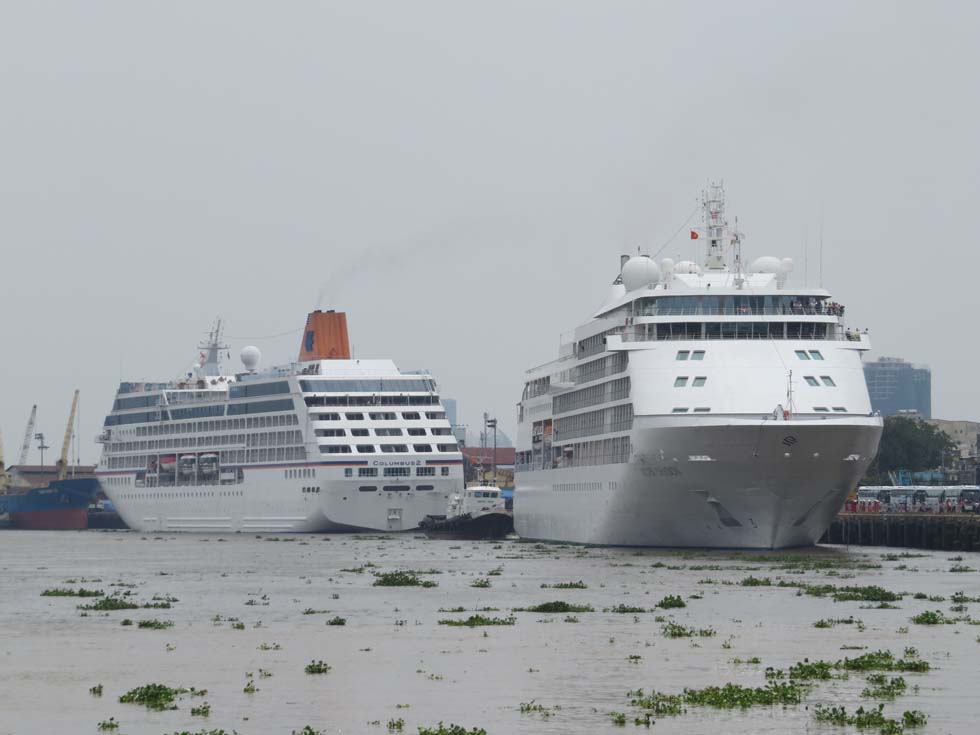
“Columbus 2” of Hapag-Lloyd and on the right “Silver Shadow”, Sai Gon Port 2013 (WS)
Deutsche Atlantik-Linie
When in the 1950s Hamburg had been almost excluded from passenger shipping, Alex Bitsch-Christensen (a Dane, supported by the Greek N.V. Eugenides of Home Lines) founded in 1958 the Hamburg-Atlantik Linie, later Deutsche Atlantik-Linie. After the first “Hanseatic” (30,030 gt, ex “Queen of Scotland” of CP) caught fire in 1966 and had to be scrapped, the new “Hanseatic” II (25,320 gt, ex “Shalom”) was acquired from Israel’s ZIM Lines and the livery changed to white with two red parallel funnels. Her cruising operation was disturbed by labour unions and in 1973 the German press reported angrily that the prestigious “Hanseatic” would be sold to the Ryutsu Kayun company of Kobe for Japan - Singapore cruises, but she was acquired by Home Lines of Greece as “Doric”. On that occasion the company’s “Hamburg” (1969/25,022 gt), a modern ship, the interior styled by architect Georg Manner, was renamed “Hanseatic” (III). The oil shock of 1973 meant the end of the highly favoured de-luxe cruises of the “Hanseatic” and she was sold via American stooges to the “hostile” Soviet Union, where she became the “Maksim Gorkiy”, later “Maxim Gorkiy (see chapter End of Liners), operating for the German company Phoenix Reisen until 2008. Attempts to rescue her failed and she went to Alang scrapyard in 2009.
Deutsche Seereederei
A quite different history had East Germany’s cruise shipping during the time of communism and Soviet occupation. The labour union FDGB bought in 1960 the “Stockholm” (12,442 gt) of Svenska Amerika Linjen and introduced her as “Voelkerfreundschaft” on affordable cruises Warnemuende – Constanza, operated by Deutsche Seereederei, in connection with flights. Later Mediterranean ports-of-call were avoided, for too many passengers took that chance for escaping from the oppressive communist regime. The operator, renamed Deutfracht, replaced the ship in 1986 by the “Arkona” (18,835 gt), which had been built in 1981 as the white/red-painted “Astor” for the unsuccessful Hadag Cruise Line of Hamburg, in 1984 acquired by Safmarine of South Africa for regular England – Cape Town sailings, then sold to East Germany. Safmarine ordered in 1985 a new “Astor”, which was delivered in 1987 to Marlan Corp. She sailed as the Soviet “Fedor Dostoevskiy” (20,606 gt) from 1988 to 1995. With German reunification, Deutfracht changed its name into Deutsche Seereederei GmbH, later Deutsche Seetouristik. The first and the second “Astor” with their characteristic funnel survived in the 21st century for years as “Astoria” and “Astor”, operating for Transocean Tours, based at Bremen.
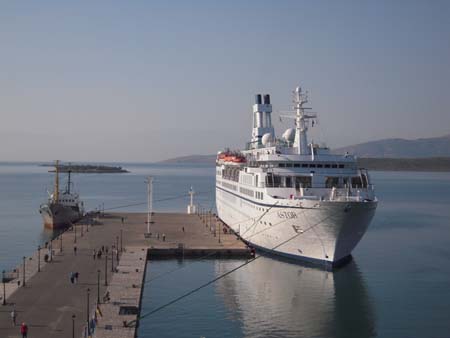
“Astor”, operating for Transocean Tours, Itea on the Gulf of Corinth, 2011 (WS)
|
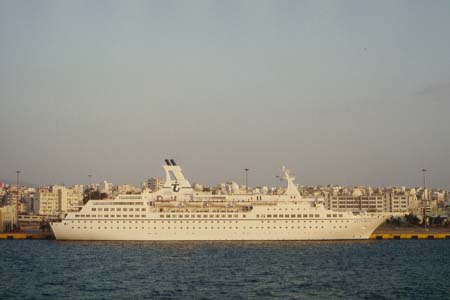
“Astoria”, operating for Transocean Tours, Piraeus 2008 (WS)
|
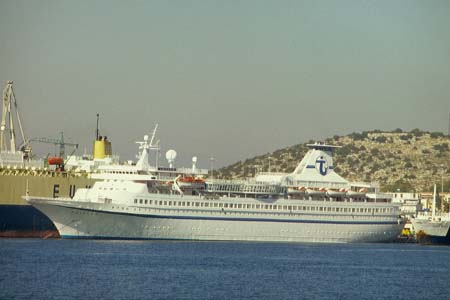 “Arielle”, the former “Nordic Prince” of RCCL, operating for Transocean Tours, Perama 2006 (WS)
“Arielle”, the former “Nordic Prince” of RCCL, operating for Transocean Tours, Perama 2006 (WS)
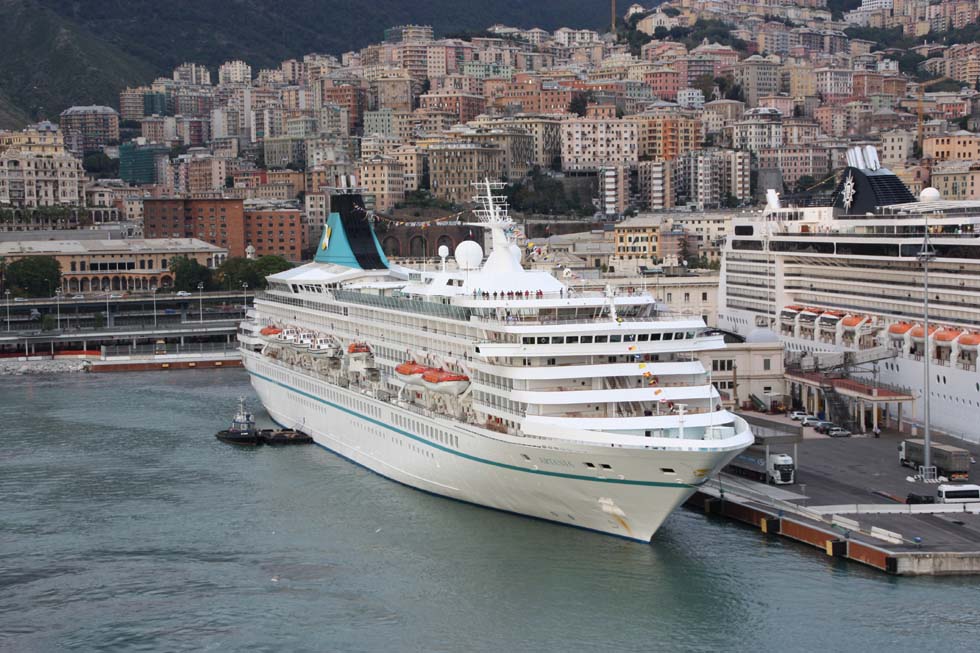
“Artania”, operated by Phoenix, ex “Royal Princess”, “Artemis”, Genova 2013 (Anton Soelch)
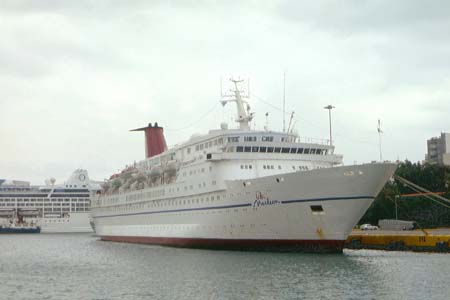
“Lily Marleen”, the former “Cunard Countess”, in the colours of Holiday Kreuzfahrten, Piraeus 2006 (WS)
|
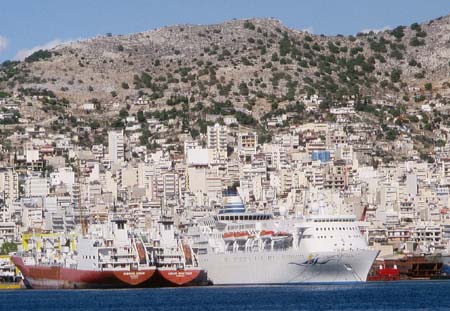
“Delphin Voyager”, the former “Orient Venus”, at Perama, Oct. 2010 (WS)
|
Phoenix, Delphin and Others
Several German companies filled a gap in the market by employing chartered ships – see the German trade press (listing all these ships would go beyond that worldwide survey). Phoenix Reisen, founded by Johannes Zurnieden, achieved its reputation mainly with the above-mentioned “Maxim Gorkiy”, then replaced by other chartered ships. In 2011 the “Artania” was chartered, the former “Royal Princess” (1984/44,588 gt), then “Artemis” of P&O. Short-lived Holiday Kreuzfahrten was remarkable for the beautiful portrait decorating the funnel of the “Mona Lisa” (the former “Kungsholm”) and for the “Lili Marleen” (the former “Cunard Countess”). Also Delphin Kreuzfahrten, taken over by Hans-Herbert Hey, owner of Hansa Kreuzfahrten, employed chartered ships, temporarily the modern “Delphin Renaissance” ex “R Seven”. In 2006 Hey signed a letter of intent with a German shipyard for commissioning a nice 34,000-ton newbuild with the proposed name “Delphin Dynasty”, but then hope was pinned on restructuring. In the meantime the “Artania” of Phoenix Reisen got famous for her TV series.
The Dreamships
Among all the other German companies, one should be mentioned in consideration of its reputation for seafaring in traditional style. It’s the Peter Deilmann Reederei which started in 1972, expanded in 1980 with the “Berlin” (9,570 gt, sold in 2005) and introduced in 1998 the “Deutschland” of 22,496 tons. This 5-star dream-ship entered the television series ‘Traumschiff’, thus succeeding the “Vistafjord”, “Astor” and “Berlin”, and she had already Mikhail Gorbachev on board. In 1999 she was the first passenger ship after decades to depart from the historic sea/rail terminal Steubenhoeft at Cuxhaven. After the death of the company’s founder Peter Deilmann in 2003, his twin daughters continued to manage the Deilmann Reederei. In 2009 the company was saved as Reederei Peter Deilmann by investors, continuing cruises with the “Deutschland”. In late 2014 the popular newspaper Bild (Nov.3) shocked the readers with the news of a menacing bankruptcy. Die Welt (13 Jan.2015) announced the “Amadea” of Phoenix Reisen as the new TV dreamship, built as “Asuka” (1991/ 29,008 gt) for NYK Cruises in Japan. The “Berlin” cruised for FTI Cruises as “FTI Berlin”, from 2014 under her old name “Berlin”.
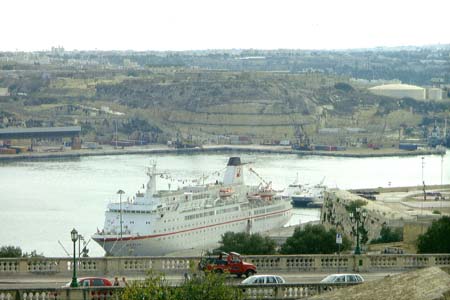
“Berlin” at Valletta, Malta, 2001 (WS)
|
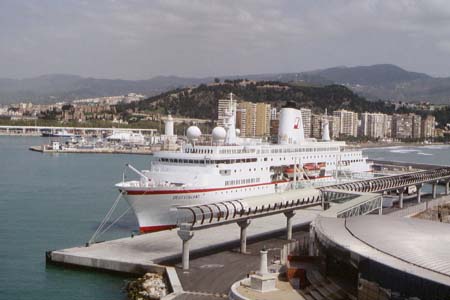
“Deutschland” at Malaga, 2010 (WS)
|
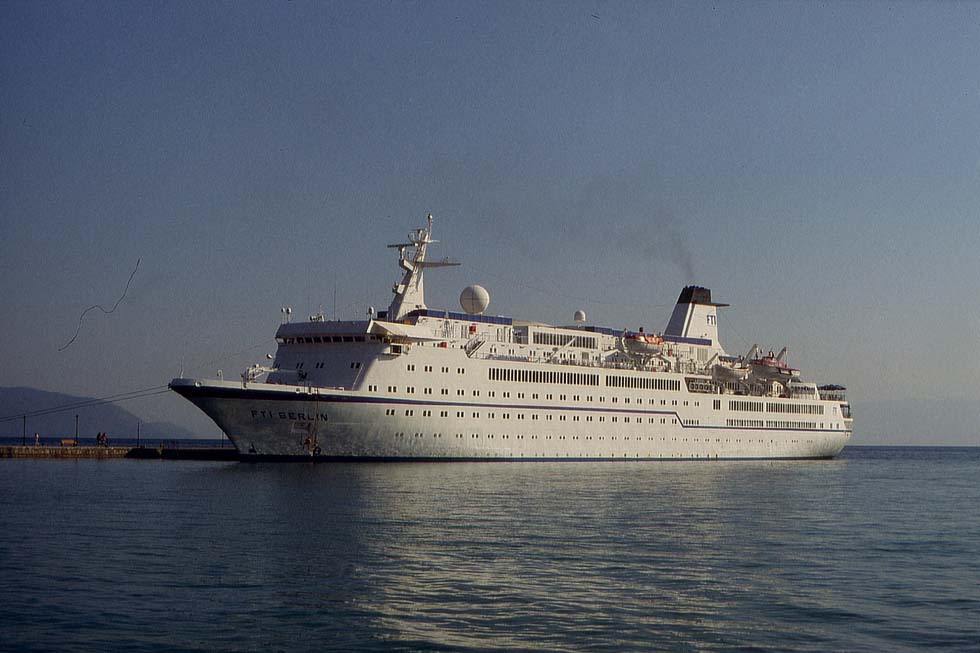
“FTI Berlin”, ex “Berlin”, departure from Itea, 2012 (WS)
|




